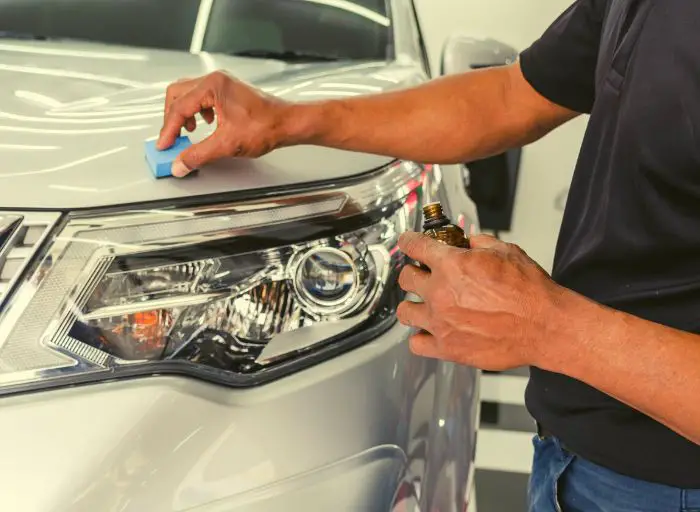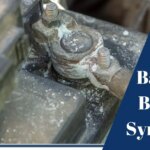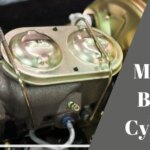
The ceramic coating is a fantastic barrier of protection for the car, but over time, it will become polluted just like anything else. They don’t work like a miracle to keep pollutants at bay. So, how to decontaminate ceramic coating to maximize its durability and performance?
In essence, impurities do not indicate that a coating has failed. A decontamination wash is generally enough, but occasionally, you must scrub the surface thoroughly. Remember to decontaminate at least every six months.
Table of Contents
How Is Ceramic Coating Contaminated?
Every day your automobile is outdoors, airborne contaminants such as salts, overspray, iron deposits, bugs, tar, road debris, and tree sap adhere to all the parts of your car, making it look dirty and dull. We call these undesirables “contaminants.”
Debris and fallout can eventually stick to the coating. This contamination could cause decreased hydrophobic characteristics or a minor roughness to the touch.
How to Decontaminate Ceramic Coating?
A complete decon wash can remove a variety of deeply ingrained contaminants since it penetrates further into the surface than more frequent maintenance washes.
Items Needed:
Before you begin the decontamination process, gather the following tools and materials:
- Microfiber wash mitt or sponge
- pH-neutral car shampoo
- Clay bar or clay mitt
- Iron fallout remover
- Tar and bug remover
- Microfiber towels
- Pressure washer or hose
#1 Pre-wash
Because you’ll be doing additional operations that directly touch the surface of your paint, having an efficient pre-wash and contact wash is crucial.
Pre-washing thoroughly with a proper chemical cleaner. When you rinse, you will have loosened and removed any significant soiling. Use Snow Foam next.
You can eventually move on to the more complex decontamination phases once you’re satisfied that your car is as clean as possible.
#2 Decon wash
Sharp metal particles, the most dangerous of entrenched contaminants, are removed during the decon-wash stage of the procedure.
Using conventional techniques makes it difficult to remove fallout; the only risk-free option to get rid of metal contamination is to dissolve it through a chemical reaction. This is why utilizing a solution designed specifically for removing ferrous materials during the decon-wash stage is necessary.
The majority of the time, one application is sufficient to remove iron particles from the surface, but for particularly severe contamination, a second application may be sprayed on and rubbed into the surface with a microfibre pad. Your paintwork should be clear of metal contamination once this has been washed away.
#3 Clay bar treatment
Clay bar treatment is necessary to eliminate embedded contaminants, such as tree sap or industrial fallout. Follow the clay bar package instructions and lubricate the surface with a clay bar lubricant. Gently glide the clay bar over the ceramic coating, applying light pressure. Regularly fold and knead the clay bar to expose a clean surface.
#4 Iron fallout removal
Iron fallout, such as tiny metal particles from brake dust, can bond to the ceramic coating. Apply an iron fallout remover to dissolve and remove these particles. Spray the product onto the surface and allow it to dwell for a few minutes. You will notice the iron fallout turning purple or red as it reacts with the remover. Rinse the surface thoroughly.
#5 Removing tar and glue
Tar, adhesive traces, tree sap, rubber, and gasoline staining are a few of the most difficult contaminants to remove.
Most of these contaminants are oil-based, sticky stains, which unites them. A potent solvent-based compound is required to dissolve them sufficiently so that they may be wiped away to remove them.
As soon as the stains begin to bleed, spritz on a light mist of product while working in small parts and wipe over with a clean microfibre. You’ll observe that contaminants are removed from your cloth right away.
#6 Completing
Any level of paint correction, from hand to machine polishing, is now possible with the car.
Inspecting the coating
Take some time to inspect the ceramic coating after the decontamination process. Look for any areas where the coating might have been compromised or damaged. If you notice any issues, it’s best to address them promptly to maintain the effectiveness of the coating.
When should you perform a decon wash?

The coating may get dull and bead water less and less with time. It depends on how often you wash with Opti coat no rinse or M-wash to retain the coating, for example. It may be three or six months. Other considerations include your residence, whether you park your car in a garage or not, how frequently you wash it, how frequently you drive it, and how often it rests for extended periods.
Rejuvenation of A Ceramic Coating
#1 Vehicle cleaning every two weeks
This is all you need to do to maintain the best possible condition for your ceramic coating. If impurities are allowed to accumulate on a coating’s surface over time, they may cause damage to the coating and significantly shorten its lifespan. However, keeping the vehicle free of these contaminants as best as possible is essential, which shouldn’t be too difficult. Things like pollen and bird dung are the main examples. Ceramic coatings greatly simplify cleaning and washing.
#2 Whenever necessary, use an iron remover
Even though ceramic coatings are designed to shield your automobile or truck’s paint and surfaces from debris, such as brake dust and iron deposits, you might also consider frequently applying an iron remover/fallout spray. If the hydrophobic characteristics of your ceramic coating are deteriorating, an iron remover can be just what you need to restore them to your coating.
Depending on where you reside, how frequently an iron remover needs to be applied can change significantly. Whether you work on a construction site, are close to a railroad, or frequently drive on dirt or gravel roads. If any of these situations describe you, you must use an iron remover more frequently than others. Use an iron remover or fallout spray to get rid of any metal particles that might be resting on top of your coating.
#3 Using soaps safe for ceramic surfaces
Many vehicle soaps on the market today include very harsh and potentially harmful ingredients that can reduce the effectiveness and lifespan of your ceramic coating. Always use a pH-neutral auto shampoo, or you might even want to consider investing in a ceramic car shampoo.
You can improve the longevity and protection of your original coating by washing your ceramic-coated car with a ceramic-based soap. This will add another thin layer of ceramic coating over your original coating. One of the simplest methods to retain your current coating is by stacking ceramic and graphene coatings on top of one another because they can bond and stack together.
#4 Spraying ceramic coating
This is sort of a continuation of #3 with the ceramic vehicle soap, except that you could buy and use a sprayable ceramic coating instead of using it. They can significantly extend the life of your original ceramic coating and take just 15 minutes to apply to your complete car. Spray coating longevity can range from three to six months, but they’re an easy and reasonably priced solution to maintain the coating you already have, costing you hundreds of dollars.
Check out This Video for How to Decontaminate a Coated Car!
FAQs
1. How often should I decontaminate my ceramic coating?
The frequency of decontamination depends on various factors such as environmental conditions, driving habits, and maintenance routines. As a general guideline, it is recommended to decontaminate your ceramic coating at least once every six months.
2. Can I use car shampoo to wash a ceramic-coated surface?
Using a pH-neutral car shampoo specifically designed for automotive surfaces is advisable. This ensures that the shampoo does not contain harsh chemicals that can damage the ceramic coating.
3. Can I apply wax or sealant on top of the ceramic coating?
Applying wax or sealant on top of ceramic coating is unnecessary, as it already provides a durable protective layer. However, if you choose to apply an additional layer of protection, make sure it is compatible with ceramic coatings and follow the manufacturer’s instructions.
4. Can I use an automatic car wash on a vehicle with ceramic coating?
While automatic car washes are convenient, they can potentially harm the ceramic coating due to the use of harsh chemicals and brushes. It is best to hand wash your vehicle or opt for touchless car washes to avoid any potential damage.
5. How long does ceramic coating typically last?
The longevity of ceramic coating can vary depending on several factors, including the quality of the coating, environmental conditions, and maintenance. On average, ceramic coatings can last anywhere from 2 to 5 years with proper care and maintenance.
Wrap Up
Decontaminating ceramic coating is essential for maintaining its protective properties and extending its lifespan. By following the outlined steps and using the appropriate tools and products, you can ensure that your ceramic coating remains top-notch, providing long-lasting protection for your vehicle.
Further Reading:
Hi everyone, My name is Ollie Barker.
As a seasoned auto expert I have 25 years of experience working in repair and detailing shops. I love to share my tips & tricks to all car lovers, so that’s why I’m here at Automotive Gearz publishing my content, sharing my passion. Also, I’ve been giving my recommendations on which products are the best to have on the market. I always thought it was hard to pick the right part, so hopefully I can make that a bit easier for you.
Hope you enjoy your time on my little blog!







